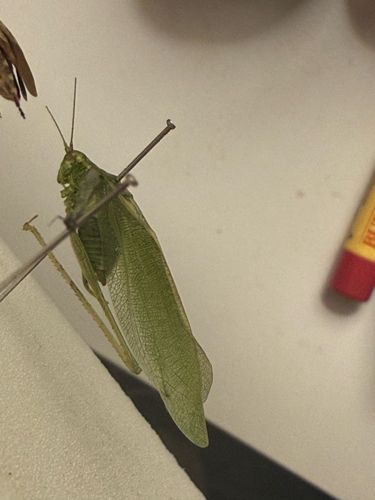Katydid (likely a true katydid or a bush katydid)
Scientific Name: Family Tettigoniidae (specific genus and species indeterminable from image)
Order & Family: Order Orthoptera, Family Tettigoniidae
Size: Generally 1 to 5 inches (2.5 to 13 cm) in body length, depending on the species. The specimen appears to be on the larger side.

Natural Habitat
Katydids are typically found in trees, shrubs, tall grasses, and other dense vegetation in various ecosystems, including forests, woodlands, meadows, and gardens.
Diet & Feeding
Most katydids are herbivorous, feeding on leaves, flowers, and seeds. Some species are omnivorous, also consuming small insects. A few are predatory.
Behavior Patterns
Katydids are known for their excellent camouflage, with bodies and wings often resembling leaves (as seen in the image). They are typically nocturnal and communicate through stridulation (rubbing body parts together) to produce sounds that attract mates or warn rivals. Their calls can vary greatly by species. They have long antennae, often longer than their body.
Risks & Benefits
Generally beneficial, as they are part of the food chain for birds and other animals. Some species can cause minor damage to garden plants or crops if present in large numbers, but significant agricultural damage is rare. They pose no direct risk to humans.
Identified on: 10/15/2025